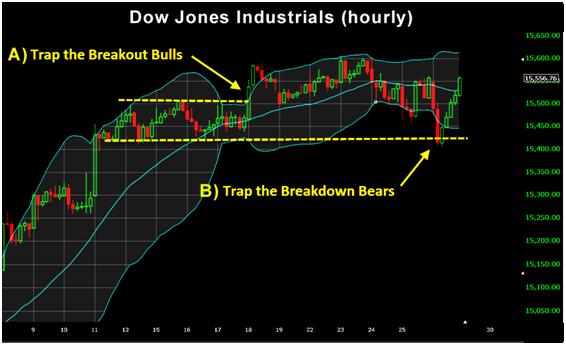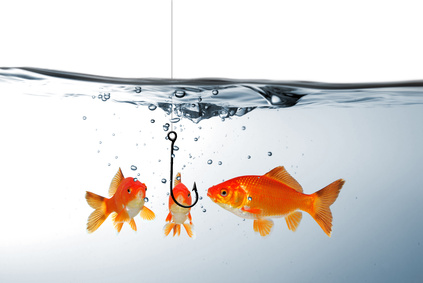As in the game of poker, the secret to professional trading is knowing the tactics of the other players. That isn’t possible at a casino, where you sit down with strangers, but it is possible in trading. Using simple charts and a few common indicators, we can put the behavior of the ‘movers and shakers’ under a microscope. We just need the right lens.
The market is an ecosystem where big fish eat small fish. How?
The Big Fish take advantage of the fact that small fish use technical analysis and they use it as a way to predict our behavior. Specifically, they love to feed off breakout traders… in both directions. Yum!
Here’s the recipe. At a key price level, reduce volatility over 20 bars (any timeframe) to create a Bollinger Band squeeze and then stage a fake breakout or two. Sell into the first one and buy the second.

You can see this tactic in operation on the hourly chart of the Dow Tracking Stock (DIA) over the last two weeks ending Friday July 26, 2013.
POINT A: TRAP THE BREAKOUT BULLS
After a strong run from the June 24 low the DIA entered a sideway consolidation. Once volatility decreased, an upside breakout occurred that trapped and eventually burned the bulls.
POINT B: TRAP THE BREAKDOWN BEARS
Seven days later a breakdown occurred that ran the sell stops from the entire 2-week consolidation and also lured in eager bears. The ensuing bear market, however, lasted less than an hour and the ensuing rally squeezed the bears.
DON’T BE FOOLED AGAIN
Breakouts and breakdowns tend to reinforce trader bias. Once we are convinced that we are right, however, we let our guard down. Furthermore, we then tend to interpret all subsequent market action as confirmation that we are right and we rationalize adverse movement because we are now psychologically invested in the outcome.
The deer is soon in the headlights.
The best breakout trader I know sells 80% of the position quickly into the initial euphoria or panic.
THE MORAL
Be the driver, not the deer.




